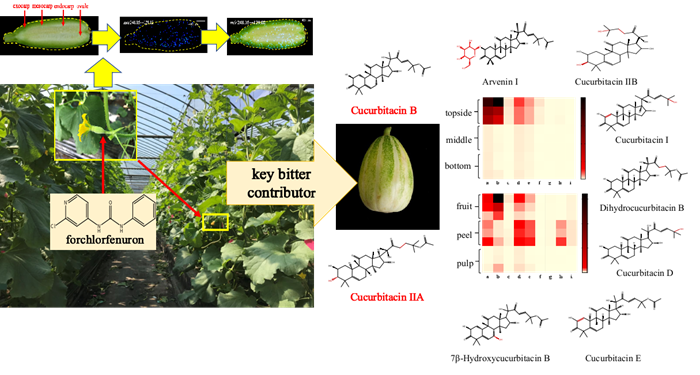The effect of forchlorfenuron application on the safety and flavor quality of oriental melon
Recently, the Agro-product Quality and Safety Testing Technology Innovation Team at the Institute of Quality Standards and Testing Technology for Agro-Products of CAAS has made considerable progress in the effect of forchlorfenuron application on the safety and flavor quality of oriental melon. Relevant results were published in Ecotoxicology and Environmental Safety , Journal of Agricultural and Food Chemistry and Foods .
Oriental melon ( Cucumis melo var. ) is widely cultivated in China. In order to improve fruit sets and increase fruit size, forchlorfenuron is widely used as a plant growth regulator in melon planting. In this study, a MALDI-MSI method was developed for the first time to characterize the time-dependent permeation and degradation sites of forchlorfenuron in oriental melon. Most forchlorfenuron was detected in the exocarp and mesocarp regions of oriental melon and decreased within two days after application. Based on the human sensory analysis, the results found that the high-dose forchlorfenuron application decreased the overall aroma and increased the bitterness of melon. Cucurbitacin B and arvenin I, as the key contributors to the bitter taste, were identified in oriental melon fruits by taste activity values (TAV; the ratio of concentration to taste threshold). This study can provide a novel idea and robust scientific basis to evaluate the influence of forchlorfenuron on the flavor quality of oriental melon, and it can broaden the research area of the effect of pesticide residue on quality, safety, and nutrition.

Figure 1: The Key Contributors to the Bitter Taste in Oriental Melon after Forchlorfenuron Application
This research was supported by the National Natural Science Foundation of China and the Science and Technology Innovation Program of the Chinese Academy of Agricultural Sciences.
Link:
1.https://www.sciencedirect.com/science/article/pii/S0147651321008125?via%3Dihub
2. https://pubs.acs.org/doi/full/10.1021/acs.jafc.3c00380
3. https://www.mdpi.com/2304-8158/12/6/1272
4. https://www.mdpi.com/2304-8158/12/15/2858
By Wang Qi
(wangqi02@caas.cn)
-
 Apr 18, 2024Opening Ceremony of the Training Workshop on Wheat Head Scab Resistance Breeding and Pest Control in Africa Held in CAAS
Apr 18, 2024Opening Ceremony of the Training Workshop on Wheat Head Scab Resistance Breeding and Pest Control in Africa Held in CAAS -
 Apr 03, 2024IPPCAAS Co-organized the Training Workshop on Management and Application of Biopesticides in Nepal
Apr 03, 2024IPPCAAS Co-organized the Training Workshop on Management and Application of Biopesticides in Nepal -
 Mar 28, 2024Delegation from the School of Agriculture and Food Science of University College Dublin, Ireland Visit to IAS, CAAS
Mar 28, 2024Delegation from the School of Agriculture and Food Science of University College Dublin, Ireland Visit to IAS, CAAS -
 Mar 25, 2024Director of World Food Prize Foundation visited GSCAAS
Mar 25, 2024Director of World Food Prize Foundation visited GSCAAS -
 Mar 20, 2024Institute of Crop Sciences (ICS) and Syngenta Group Global Seeds Advance Collaborative Research in the Seed Industry
Mar 20, 2024Institute of Crop Sciences (ICS) and Syngenta Group Global Seeds Advance Collaborative Research in the Seed Industry
